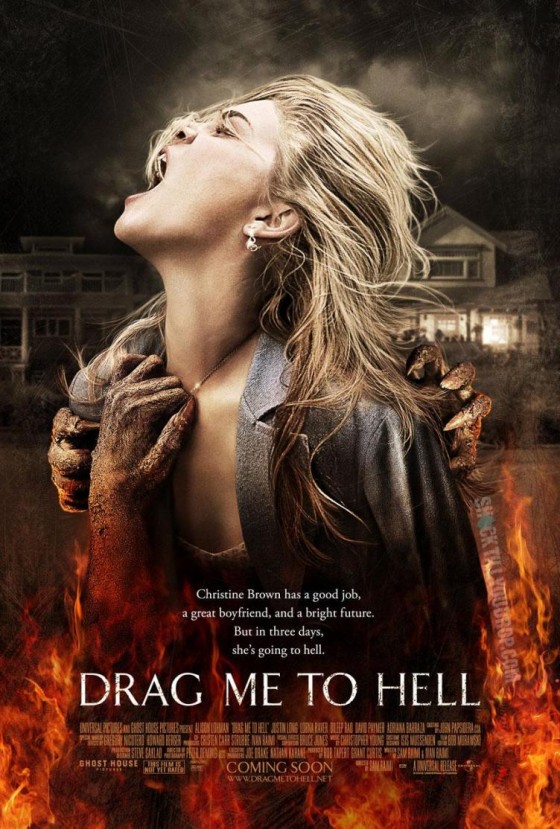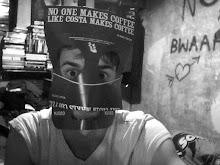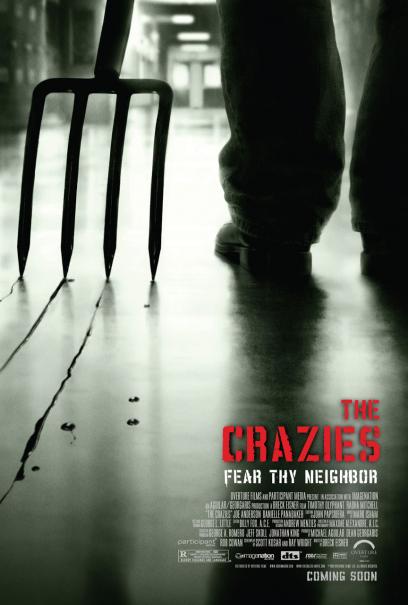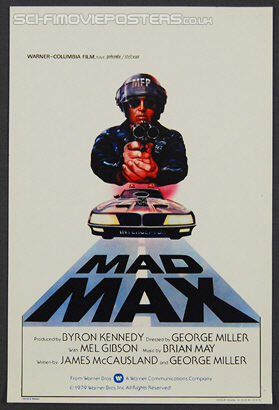
So I’ve finally got round to seeing Mr Raimi’s much anticipated return to horror. Being a long time Evil Dead (and to a much lesser extent, Spider-Man) fan – I’ve completed all the Evil Dead video games, score! – I was excited as everyone else to see what I am still willing to describe as Evil Dead 3 ½.
Christine Brown is loan officer, and one of the most genuinely kind hearted characters to appear in a horror movie in a while. Trying to get ahead in life, with her equally goody two shoes boyfriend Justin Long (who is notable here for his appearance in Jeepers Creepers [2001] which I’m a big fan of ever since it scared the shit out of me on a summers afternoon years ago) she turns down a loan extension to an old woman, in an attempt to get a promotion, little knowing that she is about to be subjected to a pretty kick-ass gypsy curse.
From the buzz at the time I was told to expect a fun and frightening “ghost train” type thrill ride – a scary movie ideal for dates and such. And I have to say this was bang on, the difficulty lies in the following; this is, after all, a DVD release review and this film is made for the cinema. Where this finds a bigger market on the home viewing front is the nerd factor. This film is chocka with references, predominantly to Raimi’s past in gruelling horror and arguably to horror staples such as Night of the Living Dead [1968] (which I gleefully enjoyed this Halloween) and Night of the Demon [1957] (as also referenced in The Rocky Horror Picture Show [1975] “Dana Andrews said prunes gave him the runes”). The great camera work is very reminiscent of the unique attempts of Evil Dead, though refined greatly at this stage in his career, and there are many sound effects and moments – notably the laughing furniture – that will appease the nerd demons. And of course the ever present cameo of the directors 1973 Oldsmobile Delta 88 is not forgotten.
Don’t see this film if you’re the kind of person to say “Oh what a stupid film they heard a noise and went down into the cellar” because this a fun light-hearted and gross-orientated flick. The film continues those horror staple sensibilities and would certainly be more at home in the 80s or 90s – it even uses the 1980’s Universal logo at the start. It does feel like a breath of musty air from the past, I imagine this film was made partially to counter the gorenography wave with a return to a night at the drive in, to suck-face with your score and nearly poop yourself whilst still having a sweet time. Interestingly, the script was written by Sam and Ted Raimi shortly after Army of Darkness [1992] but Sam started off on his road to the big time that would end up in the multi-million dollar Spider-Man franchise. This does however allude to the ongoing question (mainly posed to Evil Dead star Bruce Campbell – now getting some prominent TV work which is nice to see) as to whether he will return to the Evil Dead series. It could be argued that this is merely a warm up but I would guess due to the fact the script was written after Evil Dead, there’s probably little intention to go back, in the meantime unfortunately a remake is expected shortly, as the industry dregs up more and more head-bangingly dull 70s/80s horror classics remakes – they’ll have to run out soon, the barrel scraping will come … and drag you to hell … sigh.
It has to be remembered that despite this return to gruesome form, Sam Raimi never really intended to work in the horror genre. Growing up as a budding film maker with a love of The Three Stooges, often making direct rip-offs with his friends and siblings, his intention was always to work in comedy. However, the most money is made in horror and so Evil Dead (originally titled “Within the Woods”) was Sam’s break – despite being banned under the obscene publications act. Cheeky.
However, this does make a unique viewing experience. Raimi’s comedic sensibilities never left his films, more notably in the follow ups Evil Dead II [1982] and Army of Darkness [1992] horror and comedy are melded very effectively – the scares are there and the laughs are there and very often the scares are funny. This man really understands the comedic potential of someone being thrown, really hard, against a wall by a spirit – though I must say its funnier when its Bruce (who unfortunately has no cameo here), but maybe I’m just being feminist.
Something else that sets this apart from many horror films that have this more fun/comedic approach is the quality of the acting the central cast are all great, have a fair amount of depth but also sum up their characters perfectly. And Dileep Rao is great as the horror movie fortune teller – the film teeters between genre stereotypes and deeper performances. To summarise, if you missed this film at the cinema, like me, you missed out to an extent. That’s this films real home, if not the drive-in double features of the 1970’s. And yes the double feature comment does have something to say about the substance of the film but Sam Raimi’s a more than capable director and the film is without question 95 minutes of fun, frights and “eeeeeewww”s. This horror-comedy dynamic, often totally mishandled by others, still works brilliantly here and makes for an enjoyable film. On the other hand it will very likely disappoint if your looking for a proper horror such as the first Evil Dead, but then with Raimi’s back catalogue you should know what to expect. Evidently the release on Halloween was an apt move. Watch this for a fun night with the lights out and, even without your Oldsmobile, you’ll have a great time. Don’t forget the pop corn – it will fly.
 I'm an obsessive kind of guy, so when I find something interesting or what have you I get hooked... and more importantly for those around me, I don't shut up about it. This has been the case, for instance, with my possible overall favourite film The Warriors, many times.
I'm an obsessive kind of guy, so when I find something interesting or what have you I get hooked... and more importantly for those around me, I don't shut up about it. This has been the case, for instance, with my possible overall favourite film The Warriors, many times.











